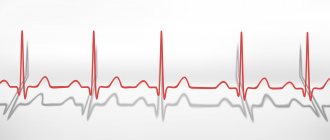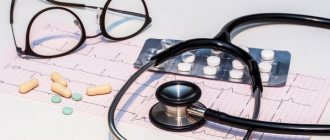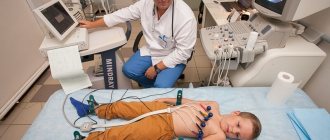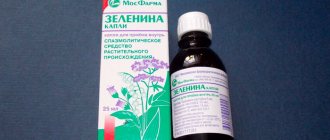Bradycardia is a decrease in heart rate that occurs as a response to external and internal stimuli. They are considered in complex, since the process often has a multi-etiological character.
What is considered a slow heartbeat? According to the World Health Organization, bradycardia is defined as heart activity less than 70 beats per minute. This indicator, however, is purely individual and depends on the characteristics of the patient’s particular organism.
The general fitness of the body, gender, and age also matter. A lot of other factors and moments.
Bradycardia is somewhat more physiological than the opposite process - tachycardia, but it still needs to be eliminated, because there are risks of cardiac arrest and the development of cardiogenic shock.
Therapy is selected under the supervision of doctors of a number of specialties. Specialized doctor - cardiologist. The rest are connected as needed.
Heart rate does not directly correlate with blood pressure levels, but there is an indirect relationship between these indicators. In order to assess the general condition of the cardiovascular system and health in general, both are subject to examination.
Features of drug therapy
Bradycardia is a decrease in heart rate less than 60 beats per minute. If the pulse decreases to 40 beats per minute, then the person needs hospitalization. An ambulance should be called.
Heart rhythm disturbances are a symptom of various pathological processes, and not an independent disease. In rare cases, bradycardia can be physiological, that is, an individual characteristic of this particular person. As a rule, such a patient does not complain, the condition of all organs and systems is normal.
In all other cases, the doctor will order an examination and, based on its results, choose the tactics for managing the patient.
Features of drug therapy:
- Treatment is carried out only if there are additional symptoms:
- there are signs of impaired blood supply;
- a decrease in heart rate causes discomfort in the patient;
- against the background of bradycardia, human activity decreases.
- Indicated if a decrease in heart rate is a sign of a chronic disease of any organ or system.
- It is mandatory when the heart rate decreases below 40 beats per minute.
- If drug therapy is ineffective, installation of a pacemaker is indicated.
At a mild stage
If there is a slight decrease in heart rate or rare attacks, you should find out what medications the patient is taking on an ongoing basis.
Most often, drugs for the treatment of arterial hypertension have a similar effect. If bradycardia develops, they are canceled or drug therapy is adjusted.
For mild cases, the cardiologist will prescribe medications with nonspecific action. They do not have a direct effect on the heart muscles, but improve metabolic processes at the cellular level and saturate tissues with oxygen.
At the middle stage
In cases of moderate severity, the use of drugs to stimulate cardiac activity is indicated. Particular emphasis is placed on the treatment of diseases that cause heart rhythm disturbances.
Goals of drug therapy:
- stopping a sudden attack;
- improvement in the condition of a patient with previously identified heart rate disorders, but suddenly worsened;
- preventive measures before installing a pacemaker.
How does bradycardia develop?
The heart is an autonomous organ whose function is regulated by the sympathetic and parasympathetic nervous systems. The impulses that cause the heart to beat are produced by the sinus node.
Weakening of the automaticity function leads to weakness of the sinus node. The slowing down of the rhythm is caused by a violation of the formation and conduction of the impulse. Bradycardia resulting from a weak pacemaker is called sinus.
The second cause of pathological bradycardia is heart block. In this case, the conduction of the impulse through the atria (sinoauricular block) or through the ventricles (atrioventricular block) is blocked.
SSSU classification
Classification is carried out according to clinical manifestations:
| Form | Option | Clinical manifestations | Disability |
| Hidden (latent) | No ECG manifestations, asymptomatic | No | |
| Compensated | bradysystolic |
| Significant limitation |
| Decompensated | Tachy-bradycardia syndrome | Bradysystolic variant is complicated by paroxysmal tachycardia | Total disability |
| Persistent bradysystolic atrial fibrillation | Bradysystolic variant |
| Partial restriction |
The indications for pacemaker implantation depend on the shape and variant of the SSSU.
Causes of slow heartbeat in adults
The causes of bradycardia are divided into three groups:
- extracardiac;
- cardiac;
- medicinal.
Non-cardiac causes include diseases that affect the functioning of the heart - decreased thyroid function, ulcerative lesions of the stomach and intestines, hemorrhagic stroke, renal failure, hypertension, meningitis.
It can also be caused by certain conditions:
- elevated temperature;
- excess calcium;
- poisoning;
- fasting;
- increased intracranial pressure, swelling and contusion of the brain.
Cardiac causes include cardiosclerosis, post-infarction condition, cardiac ischemia, inflammation of the muscular layers of the heart.
Drug-induced bradycardia
- This is a result of taking certain medications. These include cardiotonics, adrenergic receptor blockers, drugs for arrhythmia, sympatholytics (slow down the transmission of nerve impulses), calcium channel blockers.
Anticholinergics
Drugs that block M-cholinergic receptors reduce the degree of excitability of the parasympathetic nervous system, in particular the vagus nerve. Irritation of this particular area provokes a decrease in heart rate.
Typical representatives:
- Platyfillin;
- Metacin;
- Homatropine.
Drugs in this group are not used in case of individual intolerance to the components.
Children's age is not a contraindication, but they should be prescribed with caution. Drugs in this group are well tolerated, but patients complained of the following side effects:
- dry mouth;
- impaired intestinal motility, atony;
- thirst;
- dizziness;
- in rare cases - urinary retention.
Dosages are selected individually, as they depend on age, method of administration of the drug - injection, infusion, tablets or rectal suppositories, and the patient’s diagnosis.
Combination of garlic and lemon to speed up your rhythm
To prepare the product, you need to pour boiling water over ten whole lemons. After they sit for a couple of minutes, squeeze them to obtain juice. Separately, nine heads of garlic must be peeled and chopped as finely as possible, and, if necessary, mashed.
After this, chopped garlic is mixed with lemon juice and one liter of good honey, the resulting mixture is poured into a large jar.
Now you need to let the product brew for ten days in a cool, but not cold place without access to light. In this case, you should check the condition every day and gently shake the jar. The regimen of use is simple - every day you need to dissolve four teaspoons of this product in the morning.
It is advisable to take it in the morning, on an empty stomach. This must be done within three months, even if the frequency normalizes earlier. After a year, it is advisable to repeat the treatment.
This combination of substances allows you to increase vascular tone throughout the body, normalize blood pressure and improve nutrition of the heart muscle. In addition, garlic helps strengthen the immune system, thereby helping to protect the body from the negative effects of microbes.
However, since the product contains lemons, it may not be suitable for people suffering from heartburn or high stomach acidity.
Note! It is not advisable for people with ulcers or gastritis to take it. Thus, treatment with folk remedies must be carried out responsibly and with caution.
Adrenergic agonists
Adrenomimetics are drugs of plant and chemical origin that act on adrenergic receptors, causing a specific response in the body. There are 4 groups of funds in this group.
Also read: Effective drugs for the treatment of angina pectoris
When treating bradycardia, use:
- beta-adrenergic agonists - stimulate receptors in the myocardium, which helps to increase heart rate;
- adrenomimetics of presynaptic action - when used, norepinephrine is released into the synaptic cleft. This stimulates receptors and increases heart rate.
Typical representatives:
- ephedrine;
- adrenaline drugs;
- norepinephrine;
- isadrin.
Drugs in this group are not prescribed for acute heart attacks, stenosis of vascular lines, or thrombophlebitis. Among the side effects, patients noted dry mouth, nausea, hand tremors, and increased heart rate.
Valerian tincture recipe
Due to its ability to normalize the tone of the nervous system, valerian has found wide use in cardiology. It is used in cases where the main cause of bradycardia is stress or other functional disorders of the central nervous system.
Preparing the product is quite simple. Three teaspoons of finely chopped rhizomes are poured with boiled water at room temperature, and then infused in a dark room or thermos for 10-12 hours. The next day, the solution must be filtered. You should take one tablespoon three times a day.
Antiarrhythmic drugs
Antiarrhythmic drugs are a broad group of drugs for the treatment of sinus rhythm disorders, including bradycardia. Many of them additionally have a hypotensive effect and are more often indicated for tachycardia.
Typical representatives of this class of drugs:
- Novocainamide;
- Difenin;
- Ibutilide;
- Verapamil.
The list of contraindications and side effects for medications in these groups differs, since they have a certain effect on the cardiovascular system.
Treatment with folk remedies
Important!
The traditional method of treatment must be chosen correctly. It is forbidden to drink decoctions and infusions without reason, without pauses. Even natural remedies can have side effects.
For example, recipes that use lemon and sour berries can cause an increase in the acidity of the stomach, causing its walls to become inflamed. With long-term treatment with herbal decoctions, the formation of other pathologies is possible.
If a rash appears on the body, allergies, pain in the abdomen and other organs, then it is better to stop and refuse the chosen treatment or replace the remedy with another. When the heartbeat returns to normal, it is recommended to conduct additional diagnostics with a doctor in order to determine the need to continue therapy.
Yarrow infusion
When using yarrow, a person's heart rate begins to increase, due to improved liver function. Appetite increases. To prepare the medicine you need 1 tbsp. l. herbs, add a glass of boiling water and leave to brew for 20 minutes. You need to take the infusion 1 tbsp. l. 10 minutes before starting a meal.
You should drink no more than 3 times a day. During such treatment, it is important to eat properly and enrich your diet with carbohydrates. When your heart rhythm returns to normal, you should stop taking this medication and start taking it again if your heart rate decreases.
For bradycardia, it is recommended to use herbal remedies. To do this you need to connect 3 tbsp. l. nettle, currant leaves, walnut, trifolia, dandelion root, rose hips, hawthorn, you can add yarrow. After combining the herbs, add 1.5 tbsp to 250 ml of boiling water. l. collection The infusion will be ready in 3 hours; it is filtered and taken before meals 3 times a day. Daily use for 2 months will completely relieve sinus bradycardia.
Cahors with dill seeds
The drink will dilate blood vessels and increase blood pressure. To prepare 0.5 liters of wine, you need to use 5 tbsp. l. crushed dill seeds. Cook the wine over low heat for 10 minutes, which will allow the alcohol to come out, then add dill powder and continue cooking for 10 minutes. After cooking, infuse and drink 1 tbsp. l. before meals 2 – 3 times a day. You can store the medicine in the refrigerator. For treatment, you need to take the drink for 2 weeks, pause for 2 weeks and take it again.
Blend rich in essential oils and energy
A product with a large amount of essential oils can increase appetite, strengthen the heart, immune system and normalize blood pressure. You need to cut 4 lemons and add a liter of boiling water, after half an hour, grind in a blender along with water. Add 0.5 kg of chopped walnuts, a glass of sesame oil and 250 grams of sugar to the mixture. Take 1 tbsp half an hour before meals. l. Treatment requires a month, then a similar pause and another month of use.
Honey-lemon-garlic mixture
5 lemons are doused with boiling water, then the juice is squeezed out of them. To the resulting juice add 5 heads of garlic and 0.5 kg of honey, as well as chopped lemon. Leave for a couple of days, then consume once a day, 4 tsp. half an hour before lunch. The mixture should be dissolved for about a minute. The course of treatment is 2 months. It will tone the vascular system and strengthen the muscles of the heart.
Soothing massage at night
To normalize the condition, doctors recommend using massage. The left hand is usually massaged in a circular motion; this can be done using oil extract of nuts or olives. It is enough to give a massage 15 minutes a day.
Massage helps if bradycardia appears due to constant stress, pathologies of the nervous system and other emotional factors.
Infusion of valerian rhizomes
Traditional medicine recommends taking valerian infusion for a calming effect. It not only normalizes the nervous system, but also normalizes the functioning of the heart.
To prepare, you need to grind valerian root to make 3 tsp, or buy the ready-made ingredient at the pharmacy. Add a glass of boiling water to the indicated amount and leave for 8 hours. After straining, take 1 tbsp. l. 4 times a day.
This drink has one contraindication: low blood pressure. For people with such pressure, the course should not exceed 2 weeks.
Tincture of pine branches
For preparation, you can use cognac or vodka in a volume of 300 ml. 100 grams of young pine branches are added to alcohol and infused for 10 days at room temperature. The tincture is taken 10 drops 3 times a day 30 minutes before meals. The tincture must be washed down with water.
The main condition during therapy is proper nutrition.
To increase blood pressure
Drugs to increase blood pressure promote psycho-emotional stimulation and strengthen vascular tone. This causes the heart rate to increase.
Available tools:
- Caffeine sodium benzoate;
- Piracetam – can be used in old age;
- Ecdisten;
- Saparal;
Drugs in this group have a diuretic effect, insomnia, nausea, and vomiting may develop.
They are not recommended for use in childhood, with increased intraocular pressure, atherosclerosis, increased excitability, and hypertension.
Diagnostics
To diagnose bradycardia, the doctor evaluates the symptoms of the disease, clarifies the medical and family history, conducts a physical examination - listens to the heart, determines the pulse, etc. Additional research methods are also used:
- Electrocardiography (ECG) is the main method for detecting and assessing persistent bradycardia. If no changes are detected on the ECG at rest, a 24-hour ECG recording is used.
- Daily ECG monitoring is recording of a cardiogram on an outpatient basis using a small device and electrodes glued to the surface of the chest wall. Such a device records a cardiogram for 24 to 72 hours.
- Cardiac event recorder. This device monitors heart activity over several weeks. When the patient feels unpleasant symptoms, he presses a button and records an ECG at that time.
Additionally, the following studies may be prescribed for bradycardia:
- transesophageal electrophysiological study to detect sinus node dysfunction;
- tilt test (tilt test): the study helps to identify the relationship between vagotonia, fainting and bradycardia;
- ECG stress test: the doctor monitors the heart rate response to physical exercise (riding an exercise bike, walking on a treadmill).
Among the laboratory tests for bradycardia, general (to detect infection), TSH and T4 (to detect hypothyroidism) are used; on potassium and calcium levels.
If it is suspected that a rare pulse is caused by hypoxia that occurs during sleep apnea syndrome, an appropriate examination is prescribed (polysomnography or, more simply, rheopulmonography in combination with ECG monitoring).
Based on plant materials
For bradycardia, drugs based on herbal raw materials are prescribed only for mild cardiac arrhythmias and in the absence of signs of system-wide pathologies.
Available and time-tested means:
- belladonna tincture - indicated only for adult patients;
- Zelenin drops are a complex product based on belladonna extract, valerian root extract and menthol oil;
- tincture of lily of the valley – prescribed for regular attacks of decreased heart rate;
- ginseng root extract - used to treat children over 12 years old. During pregnancy, it is prohibited for use;
- extract from eleutherococcus - allowed for children and pregnant women.
Dosages are selected individually depending on the patient’s age and the presence of concomitant diseases.
The main side effect of herbal drugs is insomnia. Therefore, they are not recommended for use in the afternoon.
First aid
During an attack of bradycardia, accompanied by fainting, dizziness or shortness of breath, it is necessary to provide assistance to the patient. The first thing to do is count your pulse, preferably using a tonometer. If the drop in heart rate is not critical, you can do without medical help.
You can activate your heart function with a cup of strong coffee, physical activity (regular exercise), a warm bath, and taking cardiotonics (ginseng extract, belladonna, eleutherococcus)
Vitamins
Vitamin medications for bradycardia are not the main element of therapy. This is an aid. Indicated for proven vitamin deficiency and mineral deficiency.
What the doctor will prescribe:
- Panangin is a complex medicine containing magnesium and potassium. These microelements participate in all metabolic processes and have a stabilizing effect on the heart muscles;
- Aevit - a complex of vitamins A and E - powerful antioxidants, strengthen the vascular wall, promote stable myocardial function;
- Vitamin C as part of any vitamin complexes - to reduce the risk of developing atherosclerosis;
- Group B - Neurovitan, Neovitam, Neurobion - stabilize the functioning of the nervous system, eliminate vascular spasm, and improve blood supply to the heart muscles.
Dosages and negative effects of drugs are different. The most common side effect that patients complained about was impaired bowel movements.
If bradycardia appears, you need to undergo an examination and identify the cause of the pathology. Irregular heart rhythm is a symptom that should not be ignored. Like, Nitroglycerin or Validol under the tongue and forward towards new exploits. Such inattention to oneself can end sadly.
Prevention
Prevention of bradycardia includes:
- Timely consultation with a doctor if there are signs of various diseases to prevent them from becoming chronic;
- Prevention of infection by various infections - observing the rules of personal hygiene, avoiding crowded places during acute respiratory infections, using only your own body care items, as well as your own dishes if there is a sick person in the house;
- Proper nutrition, with preference for foods rich in vitamins and minerals;
- Take medications only in consultation with your doctor;
- Quitting bad habits - smoking, alcohol, drugs.
Symptoms of a rare pulse
Moderate bradycardia occurs without clinical signs or discomfort. A slight slowdown in heart rate to 50–60 beats does not affect blood circulation.
A decrease in frequency below 50 per minute is accompanied by symptoms such as:
- sweating,
- dizziness,
- weakness, shortness of breath with little physical effort,
- darkening in the eyes,
- semi-fainting conditions caused by hypoxia (oxygen starvation) of the brain,
- excessive fatigue.
Important! If fainting occurs, examination is mandatory. Hypoxia is felt primarily by the brain. An infrequent pulse can lead to various consequences for the heart and brain.
Causes of decreased heart rate
A slower rhythm is found in organic heart diseases. Cell death of Hiss nodes or bundles (“wires”) occurs due to impaired blood circulation in the myocardium.
Causes of bradycardia:
- cardiac ischemia,
- atherosclerotic cardiosclerosis,
- hypertonic disease,
- hypothyroidism,
- poisoning with organophosphorus compounds,
- long fasting,
- myocardial infarction,
- toxic infections - typhoid fever, sepsis,
- post-infarction cardiosclerosis.
- consequences of taking certain beta-blocker drugs, Reserpine, Nifedipine, Morphine, Digoxin.
These diseases lead to degenerative changes in the sinus node or conduction system of the heart.
In some patients, it is not possible to identify the cause of bradycardia, then it is interpreted as idiopathic.
A rare pulse is detected in children with congenital heart defects, after infections, or with poor nutrition.











